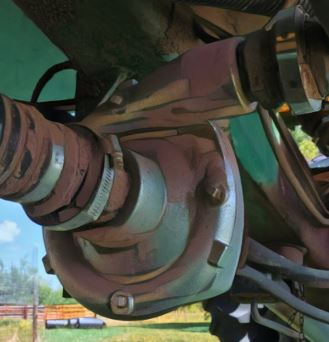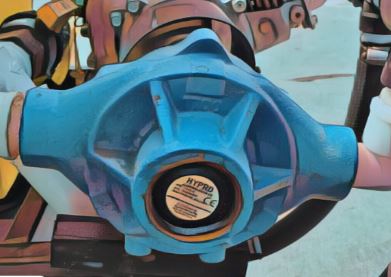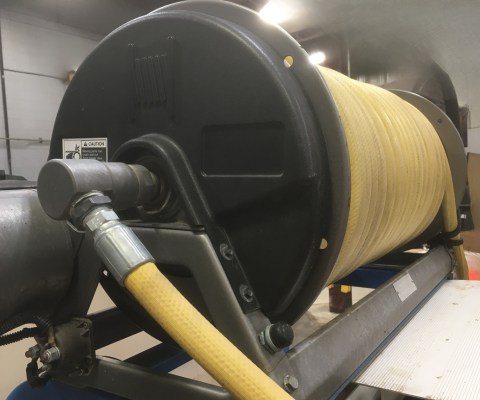A sprayer needs a pump otherwise no pressure and no liquid is moving through the system. Two of the most common types of sprayer pumps are centrifugal and roller pumps. Each type has its own set of advantages and disadvantages.
If you’re building a sprayer and trying to choose between a roller pump or centrifugal pump you’ve come to the right place. We will walk through the differences between the two and which one you should use.
Comparing Roller Pumps and Centrifugal Pumps
The key difference between centrifugal pumps and a roller pump lies in their operating mechanisms. Although both of these pumps are commonly used on sprayers, there are significant differences between them that affect performance and how they need to be installed.
To better understand how these differences will play out on a sprayer we need some background about how each one works.
Centrifugal Pumps

A centrifugal pump is commonly used on agricultural and turf sprayers that move liquid using a rotating impeller. When the impeller spins, it creates centrifugal force which pushes the liquid out of the pump. This creates the flow and pressure required to spray liquids like water, pesticides, and fertilizers over crops or lawns.
Roller Pumps

A roller pump is a positive displacement pump commonly used in agricultural spraying equipment, characterized by rollers that rotate inside a round casing. As these rollers move, they compress and push the liquid through the pump, creating a steady and controlled flow of spray material, such as pesticides or herbicides, from the tank to the nozzles.
RELATED: Different Sprayer Pump Types
Flow Rate Comparison
Centrifugal and roller pumps with the same port size (¾ inch, 1 inch, etc.) generally offer similar flow rates. However, the largest roller pumps available max out at about 60 gallons per minute while centrifugal pumps are available that will produce much higher flow rates.
There are several sizes of centrifugal pumps available. On a sprayer, they typically range from 25 GPM up to almost 400 GPM. There are centrifugal pumps that are larger than this, the size and flow rate are only limited by the space and horsepower available to drive the pump.
The roller pumps built for sprayers range from about 8 GPM up to 60 GPM. I put together a chart of several different makes and models of roller pumps and the flow rates they produce. You can see it in this guide comparing the different roller pumps used for sprayers.
| Pump Type | Potential Flow Rate Range for Sprayer Pumps (GPM) |
| Centrifugal | 25 – 400 |
| Roller | 8 – 60 |
Pressure Comparison
While the centrifugal pump offers a greater potential flow rate, the roller pump will offer higher operating pressure. A roller pump is a positive displacement pump, which means that it uses mechanical means to push fluid. This results in higher possible pressure than centrifugal pumps.
This makes them effective at overcoming friction loss. They can maintain constant pressure in the system against back pressure.
Centrifugal pumps are not positive displacement. They rely on centrifugal force to move high volumes of liquids. However, their ability to maintain pressure decreases with an increase in elevation or length of the hose due to friction loss.
Pressure Loss Example
To better understand why this difference matters, we can look at an example. Let’s consider two identical sprayers. The only difference is the pump. One sprayer has a 1-1/2 inch Hypro 1500 series roller pump. The other has a Hypro 9000 series 1-½ centrifugal pump.
Both of these pumps are PTO-driven. The sprayer has a hose reel with 300 ft of ½ inch inside diameter spray hose. To pump even just 5 gallons per minute through that much ½ inch hose it will require 90 PSI.

Our centrifugal pump will max out at about 80 PSI. This means you would not get much flow out of the spray wand and the pressure would be extremely low (about 10 psi). That’s not good enough to spray effectively.
The roller pump on the other hand will be able to spray 5 gallons per minute at around 50 PSI. This would provide a much more consistent and effective spray pattern.
Differences in Installation/Plumbing
Another crucial aspect to note when comparing a centrifugal pump and a roller pump is how they need to be installed on a sprayer. Improper installation and plumbing can lead to poor performance or pump failure.
You can see more details about hooking up a pump correctly in this guide to plumbing a sprayer pump. In this article, we will just focus on the specific differences when installing or plumbing centrifugal pumps and roller pumps.
Priming
If a pump is self-priming, it can suck liquid up into the inlet. So when you install the pump it does not necessarily need to be installed with the inlet lower than the outlet on the sprayer tank.
Roller pumps are self-priming to a degree. So they do not necessarily need to be installed below the liquid level in the tank or below the tank outlet. However, it is best to install them below the outlet of the tank so that gravity can help ensure the pump is fed enough liquid at all times. Running a roller pump dry can cause damage.
Some centrifugal pumps are self-priming, however many sprayer pumps are not self-priming. They are straight centrifugal pumps. This means they need to be installed so that the pump inlet is “flooded”. In other words, the pump inlet is lower than the outlet on the tank so that when the tank valve is open the liquid flows to the pump inlet due to gravity alone.
Pressure Relief
As mentioned earlier roller pumps are positive displacement pumps. This type of pump mechanically pushes liquid with great force and when there is no place for that liquid to go (i.e. your sprayer valves are closed) pressure increases. Eventually, the pressure reaches a point above what your hoses, valves, fittings, etc., can handle. This will cause damage to the sprayer, not to mention present a danger to anyone nearby.
Learn more in this article on regulating valves.
A roller pump always needs to have some sort form of pressure relief valve installed in the pump outlet. This protects the sprayer when the valves are closed but the pump is still running. The liquid is bypassed back to the tank so there is no damage. On many sprayers, this pressure release is accomplished by using a regulating valve. This has the dual purpose of releasing pressure as well as allowing you to set and maintain constant operating pressure.
RELATED: How to Adjust Pressure on a Sprayer
Centrifugal pumps do not require pressure relief valves. The pump can only really reach so much pressure even when the outlet of the pump is closed. When the pump is still running the impeller inside is still spinning but new liquid is not drawn into the pump. The liquid circulates inside similar to a boat tied to a dock, the propeller is spinning but the boat isn’t going anywhere.
While this is not necessarily harmful to the pump or the sprayer, i run this way for a long period of time, liquid inside the pump can get hot. Excessive heat can melt plastic impellers or other components.
Sprayers with a centrical pump still benefit from using a regulating valve as it provides the ability to regulate flow effectively. However, it is not required to avoid damage to the sprayer.
Comparing Advantages of Centrifugal and Roller Pumps on Sprayers
Centrifugal Pump
- Versatility: Can handle a wide range of chemical solutions and viscosities without damage.
- Low Maintenance: Fewer moving parts lead to less wear and tear, making them easier to maintain.
- High Flow Rates: Efficient at pumping large volumes of liquid. Suitable for large-scale applications.
- Life-span: Centrifugal pumps can last for years if properly maintained. View this guide for more details on centrifugal sprayer pump maintenance.
Roller Pump
- Cost-Effective: Typically less expensive to buy and install compared to centrifugal pumps.
- Self-Priming: Can be installed above fluid level or above the outlet of the sprayer tank. But the lift is limited.
- Pressure Capabilities: Capable of achieving higher pressures, which is beneficial for applications that require pushing fluid through a long length of hose for spot spray pest control applications.
Comparing Disadvantages of Centrifugal and Roller Pumps on Sprayers
Centrifugal Pumps
- Priming: Most centrifugal sprayer pumps are not self-priming. This means the installation location is limited and the pump could be at risk of cavitation if starved of fluid.
- Low-pressure: Centrifugal pumps are limited in the amount of pressure they can produce. Most centrifugal sprayer pumps will produce less than 100 psi. Furthermore, small hose and plumbing restrictions will result in a loss of pressure.
Roller Pumps
- Chemical Compatibility: More limited in the types of chemicals they can handle without suffering damage due to the materials used in the rollers. Abrasive products and products with solid particles will damage rollers.
- Maintenance Frequency: More moving parts in contact with chemicals can lead to faster wear and tear, requiring more frequent maintenance or replacement of parts.
- Lower Flow Rates: The roller pumps made for sprayers are limited in size. The largest available have a maximum flow of about 60 gpm. You can see a list of most roller pump models and their flow rates here.
- Lifespan: Roller pumps suffer wear to the pump housing over time. Eventually, the clearance between the pump housing and the rollers is too great to effectively move liquid. This can happen faster with abrasive chemicals.
Which Should You Use: Roller or Centrifugal Pump
| Roller Pump | Centrifugal Pumps |
|---|---|
| Small boom sprayers | Large agricultural boom sprayers |
| Pest control spot spray rigs | High-volume applications |
| Applications requiring long range spray from a wand | Pumping liquids with suspended solids |
In summary, the choice between centrifugal and roller pumps in sprayers hinges on the specific requirements of the application, including the volume required, the pressure of liquid needed, and the types of chemicals used. Centrifugal pumps offer high volume and low maintenance for large-scale applications, while roller pumps provide higher pressure and versatility.

